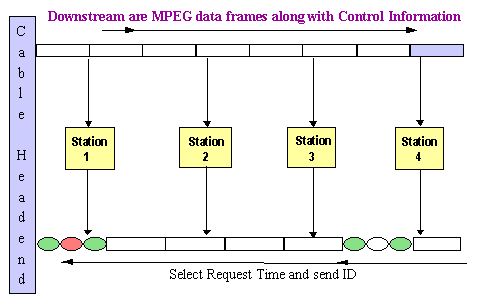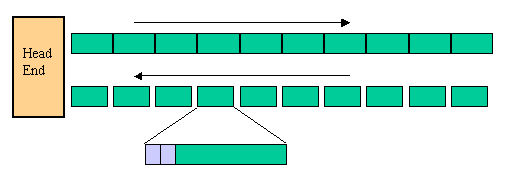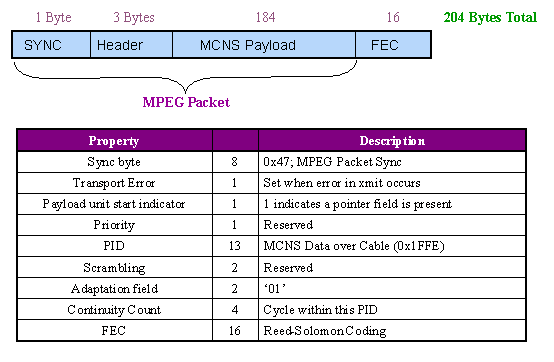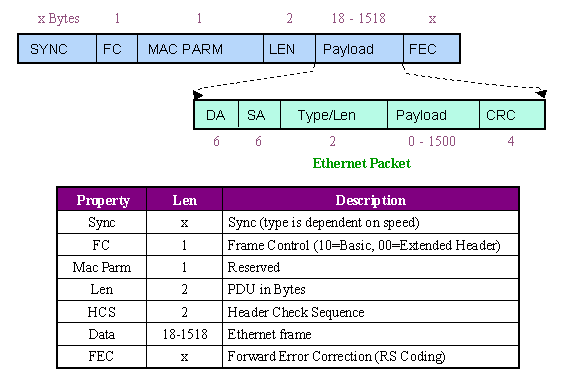|
The DOCSIS Protocols
As seen in the previous chapter, DOCSIS
is really a suite of protocols that cover many of the interfaces
between devices. From your computer to the cable modem, the protocol
is TCP/IP (OSI Layer 3-4) which is carried within an Ethernet
packet (OSI layer 2) which uses the physical interface of 10BaseT
(OSI layer 1).
The data from the home is transported between the Cable Modem
(CM) and the headend. At the headend, the Cable Modem Terminating
System (CMTS) connects into the rest of the network. In this system,
the CMTS controls all the cable modems and tells them when to
transmit and how much they may transmit.
As shown in Figure 1, there are many
CMs and only a single CMTS. In a real system, there would be many
CMTSs and each would control a specific area of the network. For
a heavy loaded system, there would be more than one CMTS for a
geographic area and they would operate at different frequencies.
The major components in a typical Cable
TV system are shown in Figure 1.

Figure 1. A typical Cable Data System
The data from the CMTS to the CMs, the
downstream direction, is encrypted for your privacy and each CM
sees all of the data but only forwards data intended for the computers
in your home. The downstream data rate is about 27 Mega bits per
second (Mb/s).
Data Formats
The upstream transmission (from the CM
to the CMTS) is done at a different frequency than the downstream
data. Because of this sharing mechanism, it is possible for the
CM to use a single cable to transmit and receive simultaneously.
The upstream data rate is set by the cable operator and ranges
from 320 Kilobits per second (Kb/s) to 10 Mb/s.
Since there can be many modems sharing an upstream channel, some
mechanism must be used to tell each modem when it should send
information. This mechanism, called Media Access Control (MAC)
is a very important part of the protocol.
As mentioned, the data from your computer to the CM uses TCP/IP
inside an Ethernet packet. This same data is also sent to and
from the CMTS but put inside another packet.

Figure 2. Downstream and Upstream data transmission
As shown in Figure 2,
the downstream data is sent in fixed size units (204 bytes). These
units are sent continuously even if there is no data to send so
that the system is kept in synchronization.
The upstream data consists of units also. The units are in terms
of time instead of bytes and each unit is 6.25 microseconds long
and the unit is known as a mini-slot. In order for a CM to transmit
data, it requests enough mini-slots to send the number bytes in
a packet.
It is the job of the CMTS to decide on what data is to be sent
downstream and to decide when to give a CM permission to transmit
and how much data the CM should transmit. Because the CMTS has
such complete control of the system, it can accurately schedule
the accurate delivery of data.
The downstream frame is below shown in Figure 3. The frame size
of 204 bytes was carefully chosen so that digital video (MPEG
frames) and the data frames (DOCSIS) can be freely mixed on a
single TV channel.

Figure 3. The downstream DOCSIS frame
The data being sent downstream
may have occasional errors and instead of asking for a retransmission,
a special mechanism is used to correct errors. This mechanism,
known as a Forward Error Correction (FEC) code is the last 16
bytes of the frame. The payload portion takes the Ethernet frame
and breaks it into segments of 184 bytes. Some bits in the Header
identify the payload as being the start of the Ethernet frame,
within the middle of the Ethernet frame, or the end of the Ethernet
frame.
The upstream frame format
is shown in Figure 4. Again, the Ethernet frame is put within
a MAC frame.

Figure 4. The upstream data frame
The upstream frame is variable length
and it uses an FEC to help decrease errors in transmission.
Power-up Sequence
When you turn the power on for the CM,
it goes through a sequence of steps before the modem can start
sending and receiving data. These steps are:
-
Initialization
The CM scans all the TV channels looking
for data. It is told which upstream channel to use.
-
Ranging
The CM adjust its transmit timing ands
adjusts its transmit power levels.
-
Establish IP connectivity
Temporary IP address are assigned for
the modem (not the computer)
-
Receives the current time of day
The modem receives configuration information.
-
Registration
CMTS sets up access to network, assigns
IDs, slots
-
Baseline Privacy
Establish the encryption and decryption
keys.
Other Messages
In addition to the description of the
messages listed above, there are many more messages that occur
in the system. The CM must be managed and isolation of problems
in the network need to be done. The Operation Support System Interface
(OSSI) is an important part of DOCSIS.
Some additional types of messages occur
between your home computer(s) and the network. There are messages
to assign the IP address of your computer, setting up groups of
computers to receive a broadcast message, and test messages for
your computer.
A description of these messages and the
messages between the units located in the headend are beyond the
scope of this seminar but are included in the suite of DOCSIS
specifications
More Information
The DOCSIS specifications are available
at: www.cablemodem.com/specifications.html
.
Additional DOCSIS seminars:
 Overview - An overview of the components of a cable
TV system.
Overview - An overview of the components of a cable
TV system.
 The DOCSIS Physical Layer - The downstream/upstream
modulation and data rates.
The DOCSIS Physical Layer - The downstream/upstream
modulation and data rates.
 Quality of Service (DOCSIS 1.1) - The changes to DOCSIS
1.0 to implement QoS.
Quality of Service (DOCSIS 1.1) - The changes to DOCSIS
1.0 to implement QoS.
In Summary:
-
Downstream frames are a fixed size and video/data
may be be intermixed on the TV channel.
-
Upstream frames are made up of a collection of
mini-slots. (A min-slot is 6.25 microseconds long)
-
There are three generations of DOCSIS protocols
and these are backward compatible.
-
DOCSIS operates using TCP/IP over Ethernet.
|

